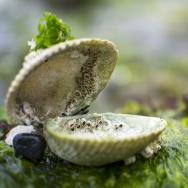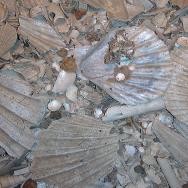Climate change results in warmer ocean temperatures, melting glaciers and more extreme weather patterns. Scientists have also observed its effects on the clams, snails, worms, crabs, urchins, starfish and more living on and in the deep seafloor off Alaska, as the ecosystem shifted from arctic to sub-arctic within the last few decades.
Now, scientists at the University of Chicago and the University of Maryland Center for Environmental Sciences have found that seashells from these creatures show the same major regime change in Alaskan waters, where the ecosystem has shifted from arctic to sub-arctic within the last few decades. It is the first time that anyone has tracked ecosystem changes through seashell samples alone—and scientists hope it will offer a new tool to track climate change in regions where animal populations haven’t been documented as fully.
“The fact that dead shells record these changes so clearly opens up a much greater area of Arctic seafloors, where we can now test for major changes in seabed communities,” said Susan Kidwell, the William Rainey Harper Professor of Geophysical Sciences, a leading scientist in the field of marine paleoecology and co-author of the study published on April 8. “Scientists weren’t there to see all the changes that ecosystems have undergone, but now they might be able to reconstruct an ecological history from the Industrial Revolution on.”
A new method
Since the 1980s, Jacqueline Grebmeier, study co-author and research professor at the University of Maryland Center for Environmental Science and a member of the steering committee for the Distributed Biological Observatory, has led annual surveys to test for shifts in animal populations linked to sea ice and water conditions in the Arctic Pacific. When Grebmeier’s team hauls up live specimens for its survey, thousands of dead shells are dragged along.
Previously the dead shells had been discarded, but UChicago graduate student Caitlin Meadows, the lead author on the study, realized this was an opportunity to test whether those shells reflected the same changes that ecologists observed, which could serve as a tool to recognize biological changes in less well-studied areas in the Arctic.
Meadows analyzed more than 14,000 shells both to track abundance—the count of each animal by species— and to calculate their organic carbon biomass, which reconstructs the original flesh content of shelled creatures using their body size as well as abundance.
“Looking at changes in carbon biomass on the seafloor is a great way to tie into climate change,” Meadows said. “We’re able to see the changes in the amount of food and how that food is flowing through the ecosystem.”
Even though she considered only the shell-producing part of the community, Meadows confirmed what ecologists had already found: There has been a shift in the ecosystem. Specifically, Meadows observed that the past ecosystem preserved in dead shells was different from the current living ecosystem. She noted a shift toward Tellinidae, a family of bivalve mollusks that are generalist feeders—a group of animals that can either eat food that has settled on the seafloor or filter food from water, so that they can survive in a changing ecosystem by filtering food from water or by eating deposits of food that have settled on the bottom.
There was also a shift in biomass, from one set of bivalve species to another within each feeding group—meaning new species took over these jobs in the ecosystem. This is part of a major shift in other seafloor animals in the same region—toward worms and away from the small crustaceans that are key foods for large mammals like gray whales.
Finally, on the basis of dead shells, Meadows found that a subset of species that now lives only close to the Alaskan shore used to live in a larger range of seafloor habitats and out into deeper waters.
“We’ve known for some time that these ecosystems are now quite different,” Kidwell said. “There’s been a real reorganization, reflecting a change in food, oxygenation and grain size—how vigorous the bottom currents are. These factors are all driven by temperature change, but have a much bigger impact on an ecosystem than warming alone.”
All of these offsets between living animals and dead shells are found in locations where Grebmeier’s group has independently demonstrated ecosystem change within the last 30 years. Since this new study detected similar numbers of living and dead bivalves even in regions where there wasn’t an observed ecosystem change, they know it’s not likely to be an error in sampling.
“Dead shells thus work well to identify areas of recent ecosystem change, and do not produce ‘false positives’ where no change has occurred,” Meadows said.
A sea of change
The Arctic Pacific off the coast of Alaska is an ecosystem with a high density of seafloor animals where “things change first and fast,” according to Meadows. The quick change is due to a phenomenon known as Arctic amplification where, as reflective ice melts, newly exposed water and land absorb more heat from the sun, resulting in even more warming.
“We were really able to isolate climate change as the driver of these shifts,” Meadows said. “The Arctic doesn’t have huge coastal settlements or intensive agriculture that might have affected coastal waters, and the study area is north of where most commercial fishing is permitted.”
Meadows and Kidwell hope that this method of using shells as a historical record of change will now serve as a tool for scientists studying other regions. “That window into the past can give us access to a much more complete picture of how the Arctic has been changing,” Kidwell said.
The shells Meadows studied are now being geologically age-dated to establish how long they have been accumulating, and thus how long ecological conditions had been stable before the recent regime change.
Next, Meadows will travel to St. Petersburg, Russia to delve into the country’s zoological museum collections for historical insights about that side of the Bering Sea, where the seafloor has been sampled as far back as the 19th century.
Citation: “High-latitude benthic bivalve biomass and recent climate change: Testing the power of live-dead discordance in the Pacific Arctic.” Meadows et al, Deep Sea Research Part II: Topical Studies in Oceanography, April 8, 2019. https://doi.org/10.1016/j.dsr2.2019.04.005
Funding: Paleontology Society and Geological Society of America, National Science Foundation

